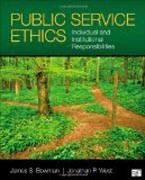
The emphasis of this text is not only on how to, but also why, and the book offers readers practical knowledge and insight into ethics in government. To that end, the book is not about right and wrong answers. Rather it aims to understand ethics and human behaviour in an analytical, yet provocative manner by extending one’s ordinary moral experience by making it explicit, clearer, and more consistent. INDICE: I. Foundations of Public Service Ethics1. Pertinence, Practicality, and Poppycock Pertinence: Reasons to Study Ethics Practicality: Commitment as a Privilege and Obligation Poppycock: Myths about Ethics Conclusion Assignments Appendix 1.1 Personal Checklists2. Perspectives on Ethics: Macro, Meso, Micro Macro Level of Analysis: Historical Dimensions Contemporary Research on Levels of Ethics Meso Level of Analysis: The Organization Micro Level of Analysis: The Individual Ethical Dilemma: Macro, Meso, Micro Ethics in Action Factors Influencing Meso-Micro Ethics Case Study 2.1 The Pennsylvania State University Athletic Sex Abuse Scandal Conclusion Assignments3. Values, Ethics, and Dilemmas Defining Values Applying Values in Public Service Defining Ethics Case Study 3.1 Challenge the Leader Domains of Human Action: Law vs. Free Choice Social Forces Endangering Ethics Case Study 3.2 Value Conflicts in World Affairs Conclusion AssignmentsII. Individual-Centered Approaches to Ethics4. Moral Development Theory Kohlberg’s Moral Development Theory: A Rational Approach Case Study 4.1 Applying Kohlberg’s Stages of Moral Development Milgram’s Shock and Zimbardo’s Prison Experiments: Ethics Under Pressure Haidt’s Social Intuitionalist Approach Conclusion Assignments5. Cognitive Ethics Methods: Results and Rule Problem-Solving Approaches Approaches to Ethics A Five-stage Method for Analyzing Ethical Issues Case Study 5.1 Applying the Kew Gardens Principles Moral Courage Applying the Five-stage Method: A Personal and Professional Conflict Conclusion Assignments Appendix 5.1 Sensitivity-Intensity Matrix Approach Appendix 5.2 The Ethical Principles Approach Case Study 5.2 Applying the Ethical Principles Approach: Playing Poker with a Vendor Appendix 5.3 Line Drawing Case Study 5.3 Applying the Line Drawing Method: A Questionable Gift6. Virtue Theory Comparing Cognitive and Virtue Ethics The Vocabulary of Virtue Habituation: The Formation of Character Case Study 6.1 Applying Rion’s Ethical Decision-Making Framework: Probing the Conscience Virtue Theory Strengths and Weaknesses Utility of Virtue Ethics for Managers: Challenge and Response Conclusion Assignments7. Conscious Deliberation and Subconscious Action: The Dishonesty of Honest People Results, Rule, Virtue: Decision-making with the Ethics Triad Utilizing the Ethics Triad Case Study 7.1 The Ethics Triad: Applying the Rational Approach to a Birthday Invitation Behavioral Ethics: What People Do vs. What They Say They Do Conclusion Assignments Appendix 7.1 Critiquing Student Case AnalysesIII. Institutional Approaches to Ethics8. Organizational Ethics Types of Organizational Strategies Case Study 8.1 Applying Rational and Behavioral Ethics Approaches: To Follow or Not To Follow Government Hiring Policy Ethical Infrastructure: Building Blocks in Ethics Management Organizational Structure Value Statements Psychological Contracts Oaths and Codes Institutionalizing Ethics Cultural Competency Conclusion Assignments9. Corruption Control Scope and Magnitude of Corruption Today Defining Corruption Causes of Corruption and Evolution of Anti-corruption Strategies Individual and Institutional Moral Failure Scandals: Types and Impacts Avenues for Reform Case Study 9.1 Applying Rational and Behavioral Ethics Approaches: Public to Private Employment on Similar Work Conclusion Assignments10. Whistleblowing in Organizations Significance of Whistleblowing Case Study 10.1 Problem Solver or Trouble Maker? Whistleblower Laws Case Study 10.2 Applying Rational and Behavioral Ethics Approaches: Cooking the Books Dissent in Organizations Case Study 10.3 The Silent Whistle Case Study 10.4 Successful Whistleblowing Trends in Blowing the Whistle Conclusion AssignmentsIV. Issues in Public Service Ethics11. Ethics and Elected Officials Case Study 11.1 Congressional Conflict of Interest Case Study 11.2 Congressional Insider Trading Ethics and Legislative Decision-Making Case Study 11.3 Robert Torricelli and the CIA The Influence of Character and Roles on Elected Officials Polarization of Politics and Ethical Implications Negative Campaigning The Problem of Dirty Hands Case Study 11.4 Applying Rational and Behavioral Ethics Approaches: Interrogation Methods Presidents and Truthfulness Influence of Citizens and Media on Politicians Case Study 11.5 Applying Rational and Behavioral Ethics Approaches: A Transgender City Manager Conclusion Assignments Appendix 11.1 Ethics Committees12. Organizational Gaming and Performance Measurement Duplicity Pressures Case Study 12.1 Organizational Cheating in Education Types of Gaming Cheating, Politicians, and Public Opinion Ethically Evaluating and Minimizing Cheating Case Study 12.2 Applying Rational and Behavioral Ethics Approaches: Electronic Surveillance in the Workplace Conclusion Assignments13. At-Will Employment The Employment At-Will Doctrine Applying the Ethics Triad to At-Will Employment Summary and Conclusion Assignments14. Open Government: A Case Study in Pay Disclosure Trends and Tensions in Open Government Background: Increasing Demand for Transparency Applying the Ethics Triad to Pay Disclosure Summary Conclusion: Implementing Balance in Transparency Policy AssignmentsV. Future History15. Choices and Strategies for the Years Ahead Moral Grandeur Moral Decay New Challenges Case Study 15.1 Applying Rational and Behavioral Ethics Approaches: Drones in Domestic Law Enforcement Guidelines for Ethical Conduct Assignments Appendix 15.1 Sample Graduate Student Action Plan
- ISBN: 978-1-4522-7413-3
- Editorial: CQ Press
- Encuadernacion: Rústica
- Páginas: 344
- Fecha Publicación: 31/03/2014
- Nº Volúmenes: 1
- Idioma:
